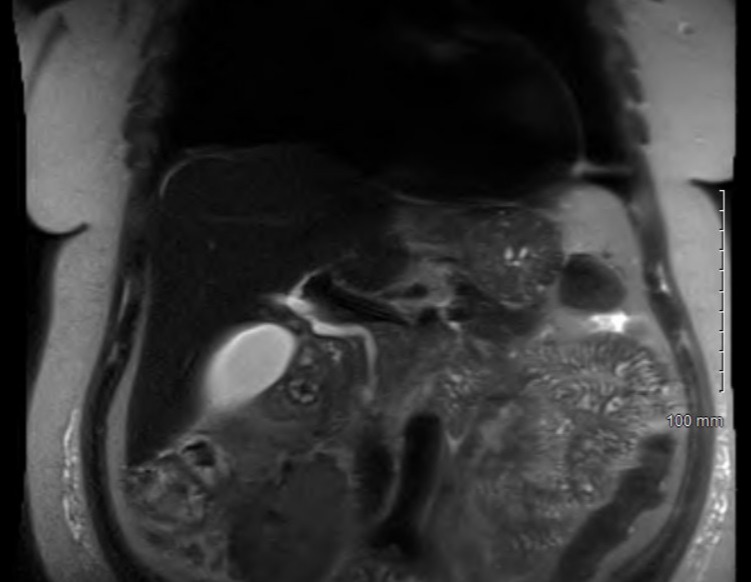Back
Poster Session A - Sunday Afternoon
A0081 - Recurrent Acute Pancreatitis in the Setting of Abnormal Pancreaticobiliary Junction
Sunday, October 23, 2022
5:00 PM – 7:00 PM ET
Location: Crown Ballroom

Kais Antonios, MD
Saint Joseph Mercy Ann Arbor
Ann Arbor, MI
Presenting Author(s)
Kais Antonios, MD1, Neil Shah, MD1, Timothy McGorisk, MD2
1Saint Joseph Mercy Ann Arbor, Ypsilanti, MI; 2Huron Gastro/Trinity Health, Ypsilanti, MI
Introduction: Abnormal pancreaticobiliary junction (APBJ) is a condition that can pose a diagnostic challenge. Certain types can cause recurrent acute pancreatitis (RAP). Normally, the major pancreatic duct and the common bile duct open into the second part of the duodenum alone or after joining as a common channel. APBJ happens when these ducts join outside the wall of the duodenum and form a long common channel ( >8 mm). We present a case of RAP where the common channel was approximately 24mm long.
Case Description/Methods: A 51-year-old female with a history of RAP. She presented with epigastric pain radiating to her back. Lipase level of 5131 U/L (Reference range 11-82 U/L). Upon review of her history, this was the 6th documented episode of acute pancreatitis in the past 6 years. She denied any significant alcohol use. Multiple abdominal ultrasounds and images did not show signs of cholelithiasis or choledocholithiasis. MRCP on admission demonstrated aberrant pancreatic duct anatomy with a long common channel of the distal bile duct and the main pancreatic duct measuring approximately 24mm in length.
Discussion: APBJ is an important, albeit rare cause of recurrent acute pancreatitis (RAP). The frequency of APBJ ranged from 1.5%-3.2% in different ethnic populations. The recurrence of acute pancreatitis is at its highest among these patients. Diagnosis is typically made with either an MRCP or ERCP. The clinical features of APBJ vary between patients. Whilst some experience RAP, others can be asymptomatic. Certain features that were associated with a higher incidence of acute pancreatitis include a long ( >21mm) and wide ( >5mm) common channel, a wide diameter of the proximal pancreatic duct ( >2.5mm), the presence of a filling defect in the common channel, and the presence of a pancreatic duct anomaly. In addition to the RAP, APBJ has been associated with chronic pancreatitis, pancreatic carcinoma, and gallbladder carcinoma as the reflux of pancreatic juice into the gallbladder may cause increased bile pressure, and result in epithelial hyperplasia. Most treatment options for APBJ have been surgical, including cholecystectomy and hepaticojejunostomy depending on the presence or absence of an accompanying choledochal cyst. Total resection of the extrahepatic bile duct and hepaticojejunostomy is recommended in children diagnosed with APBJ. Early diagnosis and early surgical treatment provide a good prognosis with a reduction in complications.

Disclosures:
Kais Antonios, MD1, Neil Shah, MD1, Timothy McGorisk, MD2. A0081 - Recurrent Acute Pancreatitis in the Setting of Abnormal Pancreaticobiliary Junction, ACG 2022 Annual Scientific Meeting Abstracts. Charlotte, NC: American College of Gastroenterology.
1Saint Joseph Mercy Ann Arbor, Ypsilanti, MI; 2Huron Gastro/Trinity Health, Ypsilanti, MI
Introduction: Abnormal pancreaticobiliary junction (APBJ) is a condition that can pose a diagnostic challenge. Certain types can cause recurrent acute pancreatitis (RAP). Normally, the major pancreatic duct and the common bile duct open into the second part of the duodenum alone or after joining as a common channel. APBJ happens when these ducts join outside the wall of the duodenum and form a long common channel ( >8 mm). We present a case of RAP where the common channel was approximately 24mm long.
Case Description/Methods: A 51-year-old female with a history of RAP. She presented with epigastric pain radiating to her back. Lipase level of 5131 U/L (Reference range 11-82 U/L). Upon review of her history, this was the 6th documented episode of acute pancreatitis in the past 6 years. She denied any significant alcohol use. Multiple abdominal ultrasounds and images did not show signs of cholelithiasis or choledocholithiasis. MRCP on admission demonstrated aberrant pancreatic duct anatomy with a long common channel of the distal bile duct and the main pancreatic duct measuring approximately 24mm in length.
Discussion: APBJ is an important, albeit rare cause of recurrent acute pancreatitis (RAP). The frequency of APBJ ranged from 1.5%-3.2% in different ethnic populations. The recurrence of acute pancreatitis is at its highest among these patients. Diagnosis is typically made with either an MRCP or ERCP. The clinical features of APBJ vary between patients. Whilst some experience RAP, others can be asymptomatic. Certain features that were associated with a higher incidence of acute pancreatitis include a long ( >21mm) and wide ( >5mm) common channel, a wide diameter of the proximal pancreatic duct ( >2.5mm), the presence of a filling defect in the common channel, and the presence of a pancreatic duct anomaly. In addition to the RAP, APBJ has been associated with chronic pancreatitis, pancreatic carcinoma, and gallbladder carcinoma as the reflux of pancreatic juice into the gallbladder may cause increased bile pressure, and result in epithelial hyperplasia. Most treatment options for APBJ have been surgical, including cholecystectomy and hepaticojejunostomy depending on the presence or absence of an accompanying choledochal cyst. Total resection of the extrahepatic bile duct and hepaticojejunostomy is recommended in children diagnosed with APBJ. Early diagnosis and early surgical treatment provide a good prognosis with a reduction in complications.

Figure: Aberrant pancreatic duct anatomy with a long common channel of the distal bile duct and the main pancreatic duct measuring approximately 24mm in length
Disclosures:
Kais Antonios indicated no relevant financial relationships.
Neil Shah indicated no relevant financial relationships.
Timothy McGorisk indicated no relevant financial relationships.
Kais Antonios, MD1, Neil Shah, MD1, Timothy McGorisk, MD2. A0081 - Recurrent Acute Pancreatitis in the Setting of Abnormal Pancreaticobiliary Junction, ACG 2022 Annual Scientific Meeting Abstracts. Charlotte, NC: American College of Gastroenterology.
